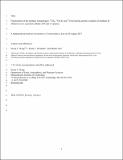Fractionation of the Methane Isotopologues ¹³CH₄, ¹²CH₃D, and ¹³CH₃D During Aerobic Oxidation of Methane by Methylococcus Capsulatus (Bath)
Author(s)
Wang, David T.; Welander, Paula V.; Ono, Shuhei
DownloadOno Wang 2016.pdf (898.6Kb)
PUBLISHER_CC
Publisher with Creative Commons License
Creative Commons Attribution
Terms of use
Metadata
Show full item recordAbstract
Aerobic oxidation of methane plays a major role in reducing the amount of methane emitted to the atmosphere from freshwater and marine settings. We cultured an aerobic methanotroph, Methylococcus capsulatus (Bath) at 30 and 37 °C, and determined the relative abundance of ¹²CH₄, ¹³CH₄, ¹²CH₃D, and ¹³CH₃D (a doubly-substituted, or “clumped” isotopologue of methane) to characterize the clumped isotopologue effect associated with aerobic methane oxidation. In batch culture, the residual methane became enriched in ¹³C and D relative to starting methane, with D/H fractionation a factor of 9.14 (Dε/13ε) larger than that of ¹³C/¹²C. As oxidation progressed, the Δ¹³CH₃D value (a measure of the excess in abundance of ¹³CH₃D relative to a random distribution of isotopes among isotopologues) of residual methane decreased. The isotopologue fractionation factor for ¹³CH₃D/¹²CH₄ was found to closely approximate the product of the measured fractionation factors for ¹³CH₄/¹²CH₄ and ¹²CH₃D/¹²CH₄ (i.e., ¹³C/¹²C and D/H). The results give insight into enzymatic reversibility in the aerobic methane oxidation pathway. Based on the experimental data, a mathematical model was developed to predict isotopologue signatures expected for methane in the environment that has been partially-oxidized by aerobic methanotrophy. Measurement of methane clumped isotopologue abundances can be used to distinguish between aerobic methane oxidation and alternative methane-cycling processes. Keywords: Methane; Clumped isotopologues; Aerobic methane oxidation; Methanotrophic cultures; Isotopic fractionation
Date issued
2016-08Department
Massachusetts Institute of Technology. Department of Earth, Atmospheric, and Planetary SciencesJournal
Geochimica et Cosmochimica Acta
Publisher
Elsevier
Citation
Wang, David T. et al. “Fractionation of the Methane Isotopologues ¹³CH₄, ¹²CH₃D, and ¹³CH₃D During Aerobic Oxidation of Methane by Methylococcus Capsulatus (Bath).” Geochimica et Cosmochimica Acta 192 (November 2016): 186–202 © 2016 Elsevier
Version: Author's final manuscript
ISSN
0016-7037
0016-7037